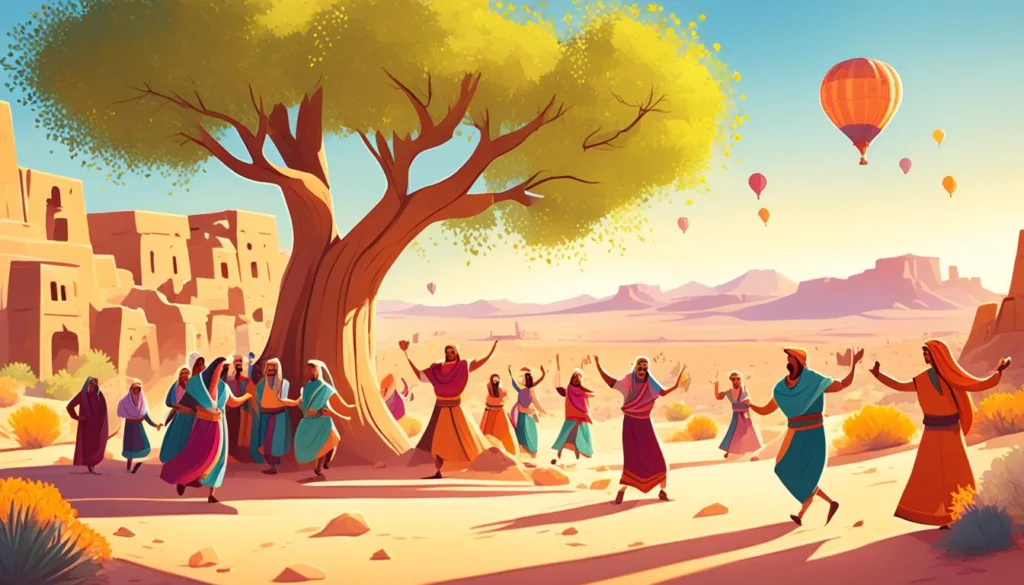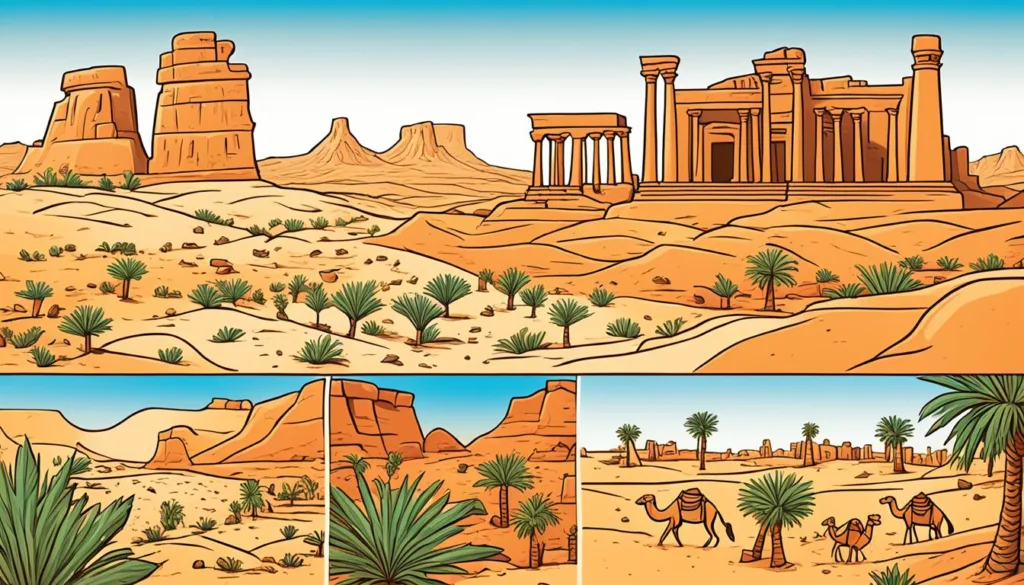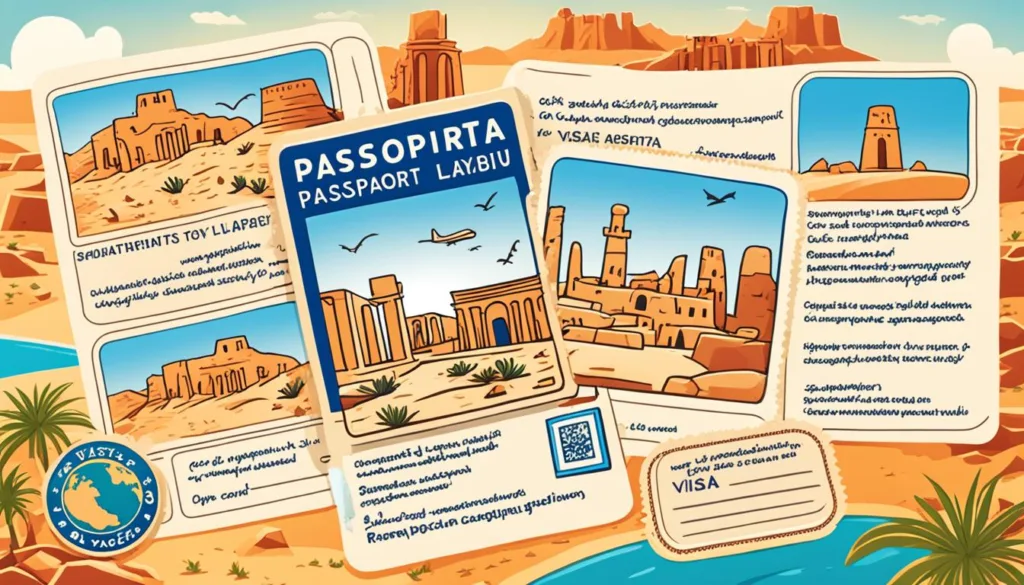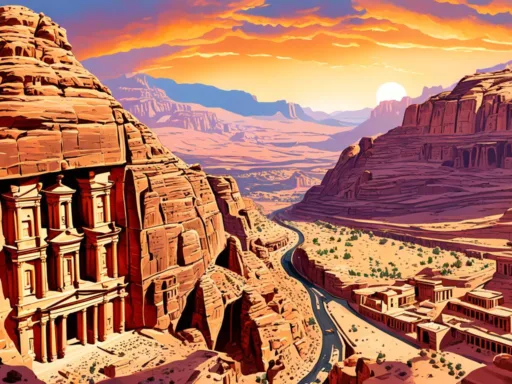Imagine stepping into a world where time stands still amidst ancient ruins and vast desert landscapes. Have you ever considered Libya as your next history-laden escape? While the country’s past complexities may make it an unconventional choice, the question beckons: when is the Best Time to Visit Libya? Unveiling the prime seasons for a Libya Trip can transform your journey into a passage through centuries, where the allure of ancient ruins and the majesty of desert landscapes await.
Join us on a discovery of the optimal Libya Climate Guide for your adventure, necessary insights for Planning a Libya Visit, and unravel the secrets that this North African jewel holds for the discerning traveler.
Embark on a voyage that defies the ordinary and delve into a landscape rich with historical treasures and natural wonders. From the spring bloom to the autumn whisper, Libya’s seasons paint a canvas that invites exploration. Prepare to traverse the crossroads of civilizations and experience the authentic heart of North Africa.
Key Takeaways
- Identify the ideal times for travel to Libya, balancing climate and cultural events.
- Explore Libya’s ancient ruins comfortably during the mild weather of spring and autumn.
- Engage with local festivities that highlight Libya’s rich heritage and community spirit.
- Plan your trip with an understanding of regional weather patterns for a seamless experience.
- Ensure you’re well-prepared for the journey with essential travel tips for safety and enjoyment.
Why Visit Libya? Discover the Charm of North African Heritage
With a history etched into its very sands and cities, Libya invites the curious and the adventurous to step back in time and experience the allure of a bygone era. From the enchanting ancient ruins that dot the landscape to the mesmerizing Sahara beauty, Libya stands as a beacon for those keen to explore UNESCO-listed heritage and immerse themselves in Libyan traditional culture.
Ancient Ruins and Historical Richness
Libya’s panoramic canvas is rich with historical sites, where stories of ancient civilizations are carved into its venerable monuments. The magnificent Roman cities such as Leptis Magna and Sabratha, both esteemed as UNESCO-listed heritage sites, offer a glimpse into the architectural genius and cosmopolitan spirit of antiquity.
Stunning Desert Landscapes of the Sahara
Be captivated by the Sahara beauty as you traverse the expansive dunes and rocky plateaus. Libya’s portion of this grand desert offers surreal vistas and experiences, from camel trekking to nights under a tapestry of stars that embellish the clear desert skies.
Traditional Berber Culture and Architecture
The labyrinthine alleys of Ghadames, with its mud-brick structures, provide insights into the enduring Libyan traditional culture. This ‘pearl of the desert’ is a testament to the sophisticated urban planning of Libya’s Berber inhabitants and their adaptation to the Saharan environment.
| Location | Cultural Significance | Activities |
|---|---|---|
| Leptis Magna | Iconic Roman city with grand monuments | Guided historical tours, photography |
| Sabratha | Historical theatre and ancient ruins | Archaeological exploration, educational visits |
| Acacus Mountains | Rock art depicting millennia of history | Rock climbing, heritage sightseeing |
| Ghadames | Traditional Berber architecture | Cultural tours, architectural appreciation |
| Sahara Desert | Vast sand dunes and starlit skies | Camel trekking, desert camping |
Understanding Libya’s Climate: A Year-Round Perspective
When planning your Libya travel season, it is crucial to consider the nation’s wide-ranging climate variability. The coast offers a Mediterranean ambiance with mild winters and pleasingly warm summers, while the vast deserts present a more extreme environment where temperatures frequently soar. The optimal weather in Libya for tourists is found during the shoulder months, when conditions are more temperate and conducive to exploration. Below, we present a concise overview of what to expect from Libya’s diverse climate throughout the year.
- Coastal Regions: Experience a mild winter with the possibility of snow, emulating the climate across the Mediterranean. Summers are hot and dry, perfect for beach enthusiasts.
- Desert Heartland: Prepare for hot days with temperatures often exceeding 40 degrees Celsius in summer months, plummeting to cooler temperatures at night.
- Spring: Embodies moderate travel conditions with warm days and a pleasant Saharan breeze, ideal for outdoor expeditions.
- Autumn: Offers a return to comfort post-summer, maintaining warmth without the intensity of the high-season heat—perfect for continuing your adventures.
To aid your travel planning, consider the table below which summarizes the climate trends that could influence your itinerary in Libya’s distinct regions.
| Season | Coastal Climate | Desert Climate | Travel Recommendation |
|---|---|---|---|
| Winter (Dec-Feb) | Mild and rainy | Chilly nights, warm days | Cultural explorations in coastal cities |
| Spring (Mar-May) | Mild and pleasant | Warm with occasional wind | Visiting ancient sites and desert trekking |
| Summer (Jun-Aug) | Hot and dry | Scorching hot with cool nights | Coastal relaxation and nighttime desert activities |
| Autumn (Sep-Nov) | Gradually cooling | Mild and comfortable | Extended travel and exploration |
In summary, the Libya climate variability significantly impacts the Libya travel season. Whether you seek the soothing Mediterranean climate or the thrilling extremes of the desert, Libya proffers a weather pattern for every traveler. Assess these climatic conditions to ensure your Libyan escapade is both exceptional and comfortable.
Best Time to Visit Libya: Spring’s Blooming Deserts
As Libya ushers in the spring season, the nation bursts into a celebration of color and culture, becoming a magnet for travelers seeking the quintessence of North African beauty and traditions. During the peak travel times in Libya from March to May, one encounters the ideal months in Libya, where the weather and festivities align to offer an unparalleled travel experience.
March to May: Ideal Touring Conditions
The span from March to May frames the most desirable window to explore Libya. This time of year is synonymous with mild temperatures ranging from 15 to 25 degrees Celsius, which sets the stage for long days of sightseeing, from the coastal stretches to the heart of the Sahara.
Festivals in Spring: Celebrating Libyan Culture
It’s not just the appealing climate that draws crowds during these months; spring festivals in Libya are a significant draw. Occasions such as the International Festival of Benghazi and Sahara Festival turn the spotlight onto Libyan cultural events, entertaining and educating visitors and locals alike with a lavish display of creativity and heritage.
Wildflower Spectacles and Cacti in Full Bloom
The Libyan landscape undergoes a dramatic transformation, as the arid regions bloom with wildflowers and cacti, punctuating the sandy vistas with dashes of vibrant colors. This natural phenomenon not only provides spectacular scenes but also symbolizes the rich biodiversity of the region.

To provide a clear perspective on the scope of activities tourists can enjoy during this peak period, the following table encapsulates key Libyan cultural events that signal spring’s arrival:
| Event | Date | Location | Activities |
|---|---|---|---|
| International Festival of Benghazi | April | Benghazi | Art exhibits, music performances, cultural workshops |
| Sahara Festival | May | Saharan Regions | Camel races, traditional music and dance, handicraft markets |
| Revolution Day Commemoration | March | Nationwide | Parades, speeches, remembrance ceremonies |
| International Women’s Day | March 8 | Nationwide | Conferences, public dialogues, celebratory events |
For those plotting a journey into the majestic landscapes of Libya, tuning your trip to coincide with the bursts of spring’s energy is likely to leave you with memories etched in the vibrancy and vitality of Libyan life at its fullest.
Moderate Autumnal Joys: The Pleasures of September to November
Autumn travel in Libya, a majestic stretch from September to November, presents an impeccable tapestry of warm days and crisp evenings, laying out an ideal canvas for travelers to explore and experience. During this period, colloquially termed Libya in fall, the nation features a serene interlude between the intense summer and the impending cool of winter. It is lauded as one of the best months to visit Libya, where the Libyan weather and tourism find a harmonious balance.
The Libyan landscape, renowned for its ethereal desert expanses and historic coastal cities, transforms with the fall ambience into a place where cultural events bloom just as beautifully as the natural surroundings. Festivals such as the Tripoli International Fair and the Libyan International Music Festival provide vivid cultural experiences against the backdrop of a milder climate. The merging of weather-perfect days with the nation’s rich cultural heritage makes autumn an ideal season for both the intrepid and the leisurely traveler.
The following table outlines the key attributes that make autumn a special time for visiting Libya:
| Month | Weather Conditions | Key Events |
|---|---|---|
| September | Mild temperatures, perfect for desert excursions | Libyan International Music Festival |
| October | Cool evenings ideal for beach outings | Tripoli International Fair |
| November | First touches of winter’s chill; season for warm libations | Preparations for National Day celebrations |
This season’s allure does not solely rest on the cultural and climate-driven aspects alone, but also the physical beauty of Libya’s alluring autumn skyline—when the sun’s descent paints the sands and ruins alike in hues of burnished gold and amber. Whether you are traversing the ancient pathways of Leptis Magna or basking in the tranquil Mediterranean aura of the coastal towns, autumn in Libya promises an unparalleled blend of beauty, temperate weather, and festive spirit.
Monthly Highlights for Travelers to Libya
Libya’s diverse calendar of events and shifting weather patterns present a kaleidoscope of experiences for eager travelers. Each month unravels its uniqueness, offering perfect moments to visit Libya by month. Delve into the heart of North Africa with our Libya monthly guide, tailored to reveal when to partake in cultural festivities, embrace the cooler climates, or venture out into warm Libyan days.

- January: Starting the year with cooler weather, it’s an optimum time to celebrate Libya’s liberation days and national flag day.
- June and July: Bring out the sun hats for the International Music Festival and the adrenaline-pumping Great Man-Made River Marathon in the summer heat.
- August: Despite the soaring temperatures, the month commemorates significant historical events, including the revolution and independence from Italy.
- September: As the heat recedes, the land breathes life into myriad festivals and marathons, perfect for those seeking cultural immersion.
| Month | Weather Patterns | Events in Libya |
|---|---|---|
| January | Cooler Climate | Liberation Days, National Flag Day |
| June | Warm and Sunny | International Music Festival |
| July | Scorching Heat | Great Man-Made River Marathon |
| August | Peak Summer Temperatures | Revolution Day and Independence Celebrations |
| September | Beginning of Cooler Evenings | Assorted Cultural Festivals and Marathons |
As your journey through Libya unfolds, attuned to the weather patterns in Libya, synchronize your travel plans with the bustling agenda of events in Libya. Venture forth and craft your itinerary to intersect with Libya’s vibrant heartbeat—one that’s as historical as it is dynamic.
Activities and Events: Aligning Your Visit with Libya’s Seasonal Festivities
Libya is awash with vibrant seasonal activities that offer an authentic gateway into its cultural heartbeat. Plan your journey around traditional Libyan national pride events to witness a country festooned in celebration, or venture out on desert adventures that encapsulate the true spirit of North Africa. Let’s delve into the yearly happenings that could shape your unforgettable Libyan cultural immersion.

National Celebrations: Marking History and Pride
The Libyan national calendar is peppered with days that commemorate the nation’s storied past and ongoing legacy. These occasions present an exceptional opportunity to share in the unity and patriotism of the Libyan people.
- Libya’s National Day: Witness the parades commemorating independence
- Revolution Day: Join locals as they celebrate the 1969 historic shift
- Liberation Day: Connect with residents marking the liberation from the dictatorship
Cultural Festivals: Immersing in the Local Experience
Throughout the year, Libya plays host to an array of cultural festivals, each offering a unique glimpse into the nation’s rich artistic landscape. From the traditional beats to contemporary expressions, these festivals are a confluence of Libya’s historic and modern narratives.
- The International Festival of Tripoli: A showcase of global artistry in Libya’s capital
- Benghazi’s Liberation Celebrations: Cultural performances in a city reborn
- Leptis Magna Festival: Ancient ruins come alive with Libyan heritage
Adventurous Escapades: Sahara Treks and Coastal Bliss
Adventure seekers will revel in the unlimited desert expeditions and serene coastal activities made possible by Libya’s climatic mien. Whether traversing the dramatic sand dunes or exploring the azure waters of the Mediterranean, Libya holds a promise of thrill and tranquility.
| Desert Adventure | Coastal Activities |
|---|---|
| Camel trekking in the Sahara | Scuba diving in the Mediterranean |
| Desert safaris to oases and Bedouin camps | Relaxing on unspoiled beaches |
| Night camping under a canopy of stars | Wind-surfing and kitesurfing adventures |
Travel Tips for Libya: Safety and Preparations
Embarking on a journey to Libya offers enchanting experiences yet demands careful attention to safety and preparatory details. Whether you’re drawn by the nation’s rich historical heritage or the lure of the Sahara, ensuring a well-planned trip is crucial. Below, we’ve assembled a guide to navigating the essentials of Libya travel safety, visa requirements, health tips, and cultural etiquette to help you gear up for an enlightening adventure.
Navigating Visa and Entry Requirements
Visa procedures for entering Libya vary depending on your nationality. It’s vital to have an up-to-date passport and, in some cases, an invitation or a letter from a Libyan sponsor. The table below presents an overview of visa guidelines:
| Requirement | Description | Notes |
|---|---|---|
| Passport Validity | Minimum 6 months | Upon Arrival |
| Tourist Visa | Required for most nationalities | Check with Libyan Embassies |
| Sponsor Letter | May be required | Varies by visa type |
| Visa on Arrival | Limited availability | Subject to change |

Health Precautions: Vaccinations and Insurance
Before embarking on your Libyan odyssey, ensuring your health safety is a priority. Verify your vaccinations are up-to-date, especially for diseases such as Hepatitis A and Typhoid, common in the region. Investing in comprehensive travel insurance, like that provided by Safety Wing, can offer peace of mind, covering potential health concerns that may arise during your travels.
- Consult your healthcare provider for travel-specific vaccinations.
- Purchase travel insurance well in advance.
- Carry enough prescription medication for the entire trip.
Local Customs and Cultural Sensitivities
Understanding and respecting the cultural etiquette in Libya is paramount for a respectful visit. Modest dress, particularly for women, and an awareness of traditional customs will facilitate interactions with locals and convey your respect for their traditions.
- Modest clothing is advised, shoulders and knees should be covered.
- Seek permission before photographing people or religious sites.
- Observe and respect local practices, particularly during the holy month of Ramadan.
By assimilating these travel tips into your planning, you’re setting the stage for a deeply enriching and safe Libyan journey.
Conclusion
In summing up the essence of Libya as your next travel destination, one cannot help but be in awe of the majestic fusion of its time-honored relics and stunning natural settings. Whether you have an insatiable zest for adventure or a thirst for historical exploration, Libya is a land that promises to fulfill these desires. For those mapping out their journey, the recommended time to go to Libya falls within the grace of spring and autumn months. These top seasons to visit Libya not only offer the most pleasant climate conditions but also coincide with vibrant cultural festivals that paint the true Libyan canvas.
A well-crafted Libya tourist guide should extend beyond mere sightseeing recommendations. It should encompass a comprehensive climate guide for Libya trips, capturing the diverse weather patterns that could influence your daily explorations. Acquainting yourself with these details ensures that each garden of Roman architecture, each caravan trail in the desert, and each spice-laden bazaar is experienced in the best possible ambiance.
Ultimately, the art of travel lies in harmonizing with the landscape and its people. Libya, with its rich tapestry of history, culture, and nature, invites heart and soul into a realm of discovery. Through thoughtful preparation that respects local customs and ensures personal safety, your visit is bound to be more than just a voyage—it becomes a profound connection with a land that has been a crossroads of civilizations for millennia. The memories you garner here will resonate deeply, enriching your soul with the stories of an evocative past and the serene beauty of a desert oasis.






